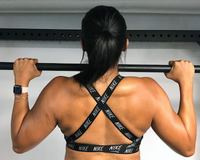The Scaption
Also known as the dumbbell scaption, the scaption is one of the best exercises for increasing deltoid muscle definition. The dumbbell scaption can be used as a lateral raise alternative as well.
However, it is also used to strengthen your back and prevent injury to your rotator cuffs.
Muscles Worked By The Scaption
Primary Muscle Groups:
The scaption primarily works your deltoids. The deltoids are comprised of three sections: front (anterior) delts, side (lateral) delts, and rear (posterior) delts.
While the entire shoulder muscle is engaged during this exercise, the scaption most effectively targets the anterior and lateral deltoids.

The scaption also works the serratus anterior, which is located on your upper rib cage. The serratus anterior helps to stabilize your shoulder blades and increase the size of your rib cage when you inhale.

Secondary Muscle Groups:
The scaption secondarily incorporates a variety of muscle groups. Your rhomboids help to stabilize your back, your forearms contract to lift the weight upwards, and your core braces to stabilize the entire motion.
Scaption Benefits
1. Improved Posture
Often, poor posture occurs due to a weakness in our back and shoulder muscles. This weakness can cause a rounding of our upper spine, otherwise known as the classic “hunched over” appearance. The scaption helps to strengthen and stabilize nearly all of the muscles involved in maintaining proper posture.
When you strengthen your shoulders, core, and back, it becomes easier to establish a strong, upright posture, which can improve any fatigue or discomfort you may experience due to poor spine alignment.
2. Increased Shoulder Strength and Mobility
Our shoulder joints allow us to move our arms in a 270 degree range. Due to their complexity, these joints are more prone to injury than others. The scaption is a deliberate exercise centered on control of the deltoid muscles.
However, it also activates a variety of muscle fibers that surround the shoulder. Thus, the scaption strengthens your shoulders and prepares them for more intense lifting motions, thereby preventing injury to your deltoids or rotator cuffs.
3. Improved Aesthetics
Many lifters and body builders tend to overtrain their chest and arms, leaving them with disproportionately smaller shoulders. The scaption is an ideal exercise to train your shoulders for size and definition.
While building muscle symmetrically is important for aesthetic benefits, it is also safer to promote balanced training in your body.
How To Do The Scaption
Equipment:
For this exercise, you will need a pair of dumbbells.
Setup:
a) Assume a standing position with your feet shoulder width apart.
b) Grab a pair of dumbbells with your palms facing inwards.
Action:
a) With a tight core and back, contract your deltoids to raise the dumbbells to shoulder height at a 30-45 degree angle. You should form a “y” formation with your arms.
b) Pause for two-three seconds at the top of the rep and slowly bring your arms back to the starting position.
c) Maintain tightness in your core and repeat!

Recommendation:
You should aim to complete 3-4 sets of 10-12 reps of the dumbbell scaption for a solid challenge. Feel free to mix up the set and rep ranges as you get more comfortable with the exercise.
Scaption Mistakes
1. Raising Your Arms Too High
During the scaption, try not to raise your arms higher than the level of your shoulders. When you raise your arms higher than this level, your trapezius muscles start to take over.
While training the traps has its benefits, the scaption is used to train the deltoids. Keep those arms at shoulder height for best results.
2. Bouncing At The Top Of Each Rep
Often times, instead of lifting in a smooth, controlled fashion, lifters will “bounce” the weight up to finish a repetition. Not only does this risk injury, but it steals from your potential gains. Bouncing is often caused by lifting too much weight.
Instead of stressing your joints, choose a lighter set of dumbbells and practice perfect form!
3. Lifting Too Much Weight
The scaption is not an exercise meant to cause major mechanical damage to the deltoid muscles through the use of heavy weight. On the contrary, this exercise is best utilized at a high rep, low weight range.
During the scaption, we are shooting to maximize the metabolic stress of many repetitions. In that way, you can boost hypertrophy in your shoulders without risking injury.
Scaption Variations
1. Lateral Raise
The lateral raise is very similar to the scaption. Instead of lifting outwards at a 30-45 degree angle, contract your deltoids to lift straight out to the sides. This exercise specifically targets your lateral deltoids.

2. Hammer Front Raise
The hammer front raise is also very similar to the scaption. Instead of lifting outwards at a 30-45 degree angle, contract your deltoids to lift straight forward. This exercise specifically targets your anterior deltoids.

3. Y-Ups
Y-ups are performed on roughly the same plane of movement as the scaption. With your palms facing down, raise your arms up to form a “Y” shape.
This exercise is simple but extremely effective!

Scaption Alternatives
If you enjoyed the dumbbell scaption, check out these deltoid exercises to improve your upper body training:
1. Reverse Dumbbell Fly
The reverse dumbbell fly is a great alternative exercise to target your rear delts. Hinge at the waist, engage your core, and retract your shoulders to bring your arms straight out to the side. Return to the starting position in a controlled fashion and repeat!

2. Overhead Press
Begin with the barbell on your front deltoids. Press upwards until your arms are locked and the barbell is above your shoulders. Then, bring the barbell back to the starting position. Repeat!
Be sure to only use your shoulder and upper body strength to lift the weight upwards. Your lower body should remain still.

3. Alternating Slicer
The alternating slicer is a complete deltoid workout. With the kettlebell in your right hand, bring your arms out in front of you with your palms facing down. Slowly bring your right arm behind your body while keeping both arms elevated.
Squeeze your rear delt, bring your right arm to the middle and pass the kettlebell to your left hand. Repeat on the left side!

Looking For More Shoulder Workouts?
Check out this intense 5-minute dumbbell shoulder workout:
Join the Invasion!
This Anabolic Aliens membership will grant you access to workout classes, rehab programs, diet plans, and more exclusive content to help you achieve sustainable success!











